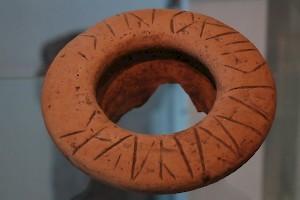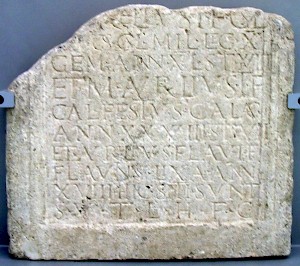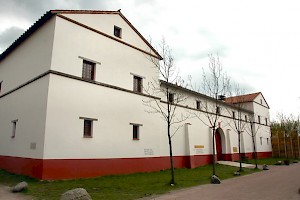Nijmegen, Hunerberg
Nijmegen: city in the Netherlands, where several Roman settlements have been discovered.
First Phase (19 BCE-c.17 CE)

In 16 BCE, a Roman general named Marcus Lollius was defeated by a group of Germanic tribal warriors, the Sugambri. The emperor Augustus decided that the best defense was to attack the Germans at home, and sent his stepson Drusus to the north. It was not the first Roman expedition to the Lower Rhine; the fortress at the Hunerberg (map) had been founded in 19 BCE, and its construction may have been one of the reasons why the Germanic tribes had become restless. However that may be, the fortress at the Hunerberg was used as a military base during Drusus' offensive across the river Rhine, which lasted from 15 to 12 BCE.

The site was well-chosen. The Hunerberg is part of an ice-pushed ridge south of the river Waal, the main distribuary branch of the Rhine. From Gaul, the river Meuse flows to the north, but it cannot break through the ridge, and turns to the west, joining the Waal further downstream. At Nijmegen, only ten kilometer separate the two streams, which means that it is easy to bring food supplies to the Hunerberg and the civil settlement in its neighborhood, Batavodurum. Besides, the native people, the Batavians, supported the Romans; when the Greek-Roman author Cassius Dio describes Drusus' campaigns, he implies that the Batavian territories had already been pacified.note
The Hunerberg fortress was very, very large. With a size of 650x650 meters, it offered accommodation to at least two legions, and possibly three. (Epigraphically attested are I Germanica and XIII Gemina.) The site was surrounded by two ditches and a large wall, with towers every 24 meter. The HQs have been identified, but were not excavated. The mansions of the officers, however, were investigated; they measured between 240 and 540 square meter, and the house of the commander, measuring 35½ x 36½ meter, was more than double that size.

It was not very long in use: after two campaigns on the east bank of the Rhine, Drusus had reached his war aims and could transfer his legions to Oberaden on the Lippe. Although the legions returned to the site during the retaliatory campaigns of Germanicus after the disaster in the Teutoburg Forest (9 CE), the site was essentially abandoned. After 17, the only (known) garrison at Nijmegen was the fort at the nearby Kops Plateau, which offered accommodation to one cavalry unit.
Second Phase (70- after 120)

The Hunerberg fortress was discovered 1916, and excavated almost completely between 1917 and 1921, and since 1951. However, the archaeologists only reached to the top level; the first building phase, described above, was not recognized until 1960. This is easy to explain: the final building phase contained stone buildings, which were easy to recognize.
The second occupation of the Hunerberg started in 70. The Batavian Revolt had shown that one cavalry unit was insufficient to control this part of the Rhine frontier, and the Second Legion Adiutrix was transferred from northern Italy to Nijmegen, where it built a bridge. It was almost immediately replaced by the Tenth Legion Gemina , which arrived from northern Spain.
The new fortress was smaller than the first one: it measured 350x465 meter or 16 hectare, which suggests that not the entire legion was stationed over here, because a full-strength legion requires a bit more space. The fortress was surrounded by a ditch that was about four meter wide, and a wall with towers at every forty-five meter. The HQs measured about 93x65 meter.
Until now, the buildings had been made of wood, but towards the end of the reign of the emperor Domitian (81-96), the fortress was rebuilt; this building phase was, as already indicated, out of stone. The site had an aqueduct and a sewer system; the underground canal, which was about 1½ meter below street level, was covered with roof tiles.

The Tenth had to abandon the fortress in 104 or 105, not very long after the rebuilding, because it was transferred to Aquincum (modern Budapest in Hungary), to take part in the Dacian Wars of the emperor Trajan. A vexillation from Britain, which consisted of parts of VIIII Hispana and other units, now occupied the site, and after 120, subunits of XXX Ulpia Victrix were the residents of the Hunerberg.
Wherever the Romans built a legionary base, other settlements were bound to grow. To the west was Ulpia Noviomagus, the city that had replaced Batavodurum as main civil settlement in the neighborhood. The six thousand legionaries that spent their pay in that town, must have been a considerable boost for the local economy.
The old river port of Batavodurum continued to be in use to receive goods. A country estate near Nijmegen called De Holdeurn was once the location of a large production center of tiles and pottery. There was also a sanctuary dedicated to the supreme god Jupiter, to Vesta, and to a local goddess named Hludana. The factory was to continue its production after the legion had left.

Of course, the Hunerberg fortress was surrounded by a civil settlement, the vicus, which appears to have contracted after the legion left. Still, the amphitheater was in use during the second century. Of this monument, there are no visible remains, but in the Mesdagstraat and the Rembrandtstraat, the place where it once stood is indicated in the pavement. East of the fortress was a large forum, which measured about 166x137 meter and is the largest known Roman building in the Netherlands. To the west of the Hunerberg base was an inn, which has been rebuilt in the Archeon archaeological park in Alphen aan den Rijn.
In the Middle Ages, the stones of the Hunerberg were taken away and reused in the city of Nijmegen. The inhabitants did not know what the ruins really were, and ascribed them - as was common in the Netherlands back then - to the Huns: the name "Hunerberg" means "mountain of the Huns".







